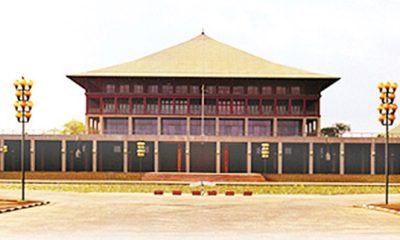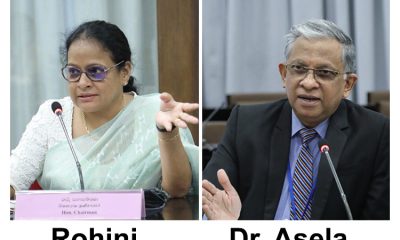Features
Surpassing neoliberal fictions towards mission-oriented state

by Dr Amali Wedagedara
In Sri Lanka, public policy lost in the neoliberal haze treats the market as a cure for all ills. Not only is the market omnipresent, but it is also omniscient and omnipotent. The charm of the ‘market’ that research and advocacy lobbyists are creating is so alluring that only a few wonder what abyss the neoliberal pied pipers are leading Sri Lanka into.
We have resorted to market solutions out of desperation. Starting from the Balance of Payment crises in the 1960s and 70s to ‘pani kuppi’ at the time of the COVID-19 pandemic, to pyramid schemes in want of quick cash, to microfinance to drive financial inclusion and eradication of poverty, we have a plethora of experiences in seeking market-based solutions.
Walking at the edge of economic bankruptcy, we are also entertaining market-fostering surgical operations to transform failing State-Owned Enterprises (SOEs) into thriving private enterprises with the hope of earning quick dollars. On the side lines, a few wonders where selling national assets will lead us. What are we going to sell next when everything sellable is sold? Is privatisation the correct strategy to take the Sri Lankan economy out of the crisis? What alternate policies should be adopted so that a second default and chronic dependence on debt can be averted?
This article invites the readers to revisit dominant narratives on the market and business. While historicising the dominant narratives on the market and industry along with the local and global examples, the article builds a case for repurposing the Sri Lankan State towards the mission of steering the economy out of the crisis. Economic theories and frameworks do not stand alone in the history.
They evolve and adapt to changing circumstances. The Internet and mobile phones, built through government-funded projects, offer a vast pool of knowledge and wisdom at our fingertips. So, we need not act as if we are trapped in a time capsule of a bygone era where information was scarce, and people lived in isolation and disconnected.
Markets work; govts don’t
Contrary to popular belief, markets cannot exist by themselves. They need to be created. From the point of creating necessary legal frameworks for the markets to exist, governments regulate them to ensure democratic control of the market. Government investments in technology, IT, medicine, and biotech have been fundamental to modern miracles like the Internet and the iPhone.
In times of crises, markets fail. Countless examples from the post-World War II, 9/11, the Global Financial Crisis in 2008, and the COVID-19 pandemic in 2020 illustrate the proactive role played by the governments in resurrecting the markets. Governments built markets from scratch, injected extra cash into troubled industries, provided concessional loans and subsidies or simply bailed them out.
Governments from the US, the UK, and Sri Lanka used public money to correct the market failures even when the markets were at fault. The best example is the Global Financial Crisis in 2008. After the Easter Bomb attack in 2019, the Government of Sri Lanka provided concessional loans to exporters and hoteliers using public money. Yet, many evade or dodge tax payments. In that sense, markets are parasites seeking benefits and externalising social costs.
‘Trickle down’ is the common belief that justifies lower taxes to the corporate sector. Even though it’s proven wrong innumerable times, pro-corporate policymakers and research and advocacy lobbies still hold onto it. For example, the non-implementation of a tax on bondholders who did not participate in the Domestic Debt Optimisation (DDO) in Sri Lanka was commended by saying it would have become a ‘revenge tax’ and discourage investments.
An incalculable number of tax holidays and concessions given to BOI companies, big agribusinesses, and others in the corporate sector to encourage private sector-led growth in Sri Lanka for decades have not nurtured a robust private sector economy. In an article in the New York Times in 2010, Paul Krugman compared the belief in trickle-down to “old voodoo economics – the belief, refuted by study after study, that tax cuts pay for themselves.
” Instead of trickle-down, tax relief to the rich ‘vacuums up’ the income and wealth of the working people. Wealth segregation in the upper echelons of income groups is the outcome. The UNDP Report in 2023 identified Sri Lanka as one of the four Asian countries having the highest wealth inequality.
Markets are efficient; govts are not
‘Efficiency and productivity’ of the markets are another idea blown out of proportion by the market pundits. They forget that the markets are heterogeneous, differing from the goods and services they exchange. There are rice markets, shoe markets, toothpaste markets, fuel markets, education markets, health markets, organ trading markets and many more. Governments are better placed to provide some goods and services. For example, the government is the most efficient and productive provider of public goods and services such as health care, education, infrastructure, social security, energy, and R&D.
The Nobel Laureate economist Kenneth Arrow, in 1963, argued that private healthcare markets were inefficient due to uncertainty related to risks of illness and information. Adverse selection pushes the cost of health insurance up, excluding many who cannot afford to pay. According to OECD statistics, the per capita cost of health care is much lower and people are healthier in countries with a more significant government role in public health care services than in countries with private health care, such as the USA.
Free markets and perfect competition
The market is neither free nor perfectly competitive. Well-connected and big market players create information asymmetries that enable them to take advantage. The notorious Bond Scam in Sri Lanka is a good example. Cartels and oligopolistic control, hoarding and artificial scarcities, corporate lobbying, and shell companies are all about corporate corruption and market manipulations.
Apart from the bond scam, our day-to-day lived existences are heavily affected by corporate corruption. Take the sugar, cigarette, and forex scam at the height of the economic crisis. Even the immunoglobulin fraud unravelling. The private market players are equally at fault as the politicians involved. The same goes for privatising SOEs. Each privatising project, past and present, has involved significant corruption.
A creative and innovative government is crucial in a crisis, even for a market-led economy. A government that parrots enunciations of the multilateral lending institutions such as IMF and World Bank is at the risk of becoming a puppet of global and local capital and will end up deepening the crisis while killing the local economy.
In contrast, a visionary mission-oriented government will take swift actions to alleviate the pain of crisis on the public, nurture agriculture and local industries to ensure that the local economy will not suffer in the short and medium term, use SOEs efficiently and effectively to drive economic growth in the medium and long run. Instead of short-termism, a mission-oriented government will focus on the optimal use of resources while enhancing the capabilities of the State.
Mission-oriented govts
The history of governments (or states) illustrates how imaginative and creative governments have led the economy and society towards progress. Be it the US government in 1800 mired in a Civil War, in the aftermath of the Great Depression, Japan in the post-World War II, or poverty-stricken South Korea in the 1980s, or poverty-stricken Taiwan also faced with an existential crisis in 1950s or poverty-stricken China, or our own neighbour India, governments near and afar have shown that they have a central role in leading the economy forward. These governments, encountering their respective challenges, underwent radical transformations to deliver impressive outcomes.
They undertook high-risk investments in technology, infrastructure, manufacturing, and pharmaceutical industries while orienting business towards a social purpose through market regulations. Public agencies in Europe, Japan, Taiwan, China, Singapore, and South Korea, public banks in Europe and Germany, and multiple arms of the Department of Defence in the US (Defence Advanced Research Projects, CIA, US Navy) have been the bedrock of subsequent technological and manufacturing revolutions that these countries are known for. These breakthroughs functioned as stimulants for private businesses and were open to take advantage.
SL Developmental state and SOEs
The bold post-colonial State in Sri Lanka gearing national resources for innovation and change necessary to drive the industrial policy to advance development established SOEs in critical sectors of the economy. Mindful of the national sovereignty as a newly independent small State and accounting for the need for equitable development as a Third World country, foreign-held industries in energy and banks were nationalised. It was a with futuristic vision, courageous to withstand the risk of facing backlash from countries in the Global North which owned these industries.
SOEs have played a vital role, from fostering domestic industries while creating the domestic market to expanding electrification beyond income barriers and driving domestic production of textiles and manufactured goods. Even in their dilapidated form due to long-term neglect and purposeful undoing, SOEs remain valid and critical for post–crisis growth today. SOEs represent the necessary infrastructure that enables Sri Lanka to break free from debt dependency and move forward as an innovative and industrialised economy.
The market Pied Pipers argue that privatising SOEs will bring in quick dollars to finance the budget deficit. Privatising SOEs will appease the IMF and World Bank. While privatising SOEs would be the easiest, and most lazy public policy position that the government could assume, there are many other ways to lead market reforms and bridge budget deficits. SOEs should not be the scapegoats for lacklustre political leaders and unimaginative and mundane policymakers.
Privatising SOEs is a costly affair. Leave alone the cost of transforming SOEs into sellable enterprises and listing them in the Stock Market. The social cost, including the distributional cost of privatisation, is immense. For example, how long did it take the Ceylon Electricity Board to expand the electrification in Sri Lanka to include low-income households?
Tariff revisions over a few months have undone years of hard work by denying over 500,000 households their right to electricity. What is the social and distributional cost of 500,000 households going dark? Spillovers of denial of electricity to children, their education, and small and medium industries have a generational effect in regressing into history. Going back to the dark ages!
What reforms do the SOEs need? This is a valid question that we should mull over.
Political reforms should lead the way. It’s common knowledge that the use of SOEs as avenues to create employment for political clientele is at the root of the deterioration of SOEs. All the ministers holding public office since 1977 are guilty of overstaffing SOEs and appointing mediocre managers and CEOs. Not even a private business would survive such mismanagement. While creating employment opportunities is essential, it needs far-sighted approaches linked to the distribution of wealth, a better education system, and a balanced approach to the agriculture, manufacturing, and services sectors of the economy.
Organisational reforms should follow political reforms. Reorienting SOEs for their public purpose and holding the management accountable to the mandate of respective SOEs is essential. It could be harnessed with incentives to reward managers and employees for their contributions to enhance efficiency, productivity, and public service.
Create a mechanism to monitor SOEs. Ministerial oversight on SOEs as practised in Sri Lanka now is not working. Often, the Minister and the bureaucracy neither have the expertise nor information to supervise and monitor SOEs. As much as SOEs should generate quarterly and annual reports on their performance, the oversight agency should have the necessary skills to monitor and supervise them. Mariana Mazzucatto, influenced by examples from Italy, Spain, the UK, Sweden, and France, introduces the idea of a ‘State Holding Company’ as an overarching oversight agency to supervise and monitor SOEs.
To locate the idea in the SOE landscape in Sri Lanka would roughly be as follows: (See chart)
Rather than attempting to be prescriptive or to plant models from elsewhere, I want to expand the debate beyond the privatisation discourse. Democratic ownership and control of SOEs is not limited to Sri Lanka. It is a successful model which benefits the public, including private businesses. An entrepreneurial State could be the engine of growth, navigating society and the economy out of the crisis.
The writer is a feminist political economist.
Features
The heart-friendly health minister

by Dr Gotabhya Ranasinghe
Senior Consultant Cardiologist
National Hospital Sri Lanka
When we sought a meeting with Hon Dr. Ramesh Pathirana, Minister of Health, he graciously cleared his busy schedule to accommodate us. Renowned for his attentive listening and deep understanding, Minister Pathirana is dedicated to advancing the health sector. His openness and transparency exemplify the qualities of an exemplary politician and minister.
Dr. Palitha Mahipala, the current Health Secretary, demonstrates both commendable enthusiasm and unwavering support. This combination of attributes makes him a highly compatible colleague for the esteemed Minister of Health.
Our discussion centered on a project that has been in the works for the past 30 years, one that no other minister had managed to advance.
Minister Pathirana, however, recognized the project’s significance and its potential to revolutionize care for heart patients.
The project involves the construction of a state-of-the-art facility at the premises of the National Hospital Colombo. The project’s location within the premises of the National Hospital underscores its importance and relevance to the healthcare infrastructure of the nation.
This facility will include a cardiology building and a tertiary care center, equipped with the latest technology to handle and treat all types of heart-related conditions and surgeries.
Securing funding was a major milestone for this initiative. Minister Pathirana successfully obtained approval for a $40 billion loan from the Asian Development Bank. With the funding in place, the foundation stone is scheduled to be laid in September this year, and construction will begin in January 2025.
This project guarantees a consistent and uninterrupted supply of stents and related medications for heart patients. As a result, patients will have timely access to essential medical supplies during their treatment and recovery. By securing these critical resources, the project aims to enhance patient outcomes, minimize treatment delays, and maintain the highest standards of cardiac care.
Upon its fruition, this monumental building will serve as a beacon of hope and healing, symbolizing the unwavering dedication to improving patient outcomes and fostering a healthier society.We anticipate a future marked by significant progress and positive outcomes in Sri Lanka’s cardiovascular treatment landscape within the foreseeable timeframe.
Features
A LOVING TRIBUTE TO JESUIT FR. ALOYSIUS PIERIS ON HIS 90th BIRTHDAY

by Fr. Emmanuel Fernando, OMI
Jesuit Fr. Aloysius Pieris (affectionately called Fr. Aloy) celebrated his 90th birthday on April 9, 2024 and I, as the editor of our Oblate Journal, THE MISSIONARY OBLATE had gone to press by that time. Immediately I decided to publish an article, appreciating the untiring selfless services he continues to offer for inter-Faith dialogue, the renewal of the Catholic Church, his concern for the poor and the suffering Sri Lankan masses and to me, the present writer.
It was in 1988, when I was appointed Director of the Oblate Scholastics at Ampitiya by the then Oblate Provincial Fr. Anselm Silva, that I came to know Fr. Aloy more closely. Knowing well his expertise in matters spiritual, theological, Indological and pastoral, and with the collaborative spirit of my companion-formators, our Oblate Scholastics were sent to Tulana, the Research and Encounter Centre, Kelaniya, of which he is the Founder-Director, for ‘exposure-programmes’ on matters spiritual, biblical, theological and pastoral. Some of these dimensions according to my view and that of my companion-formators, were not available at the National Seminary, Ampitiya.
Ever since that time, our Oblate formators/ accompaniers at the Oblate Scholasticate, Ampitiya , have continued to send our Oblate Scholastics to Tulana Centre for deepening their insights and convictions regarding matters needed to serve the people in today’s context. Fr. Aloy also had tried very enthusiastically with the Oblate team headed by Frs. Oswald Firth and Clement Waidyasekara to begin a Theologate, directed by the Religious Congregations in Sri Lanka, for the contextual formation/ accompaniment of their members. It should very well be a desired goal of the Leaders / Provincials of the Religious Congregations.
Besides being a formator/accompanier at the Oblate Scholasticate, I was entrusted also with the task of editing and publishing our Oblate journal, ‘The Missionary Oblate’. To maintain the quality of the journal I continue to depend on Fr. Aloy for his thought-provoking and stimulating articles on Biblical Spirituality, Biblical Theology and Ecclesiology. I am very grateful to him for his generous assistance. Of late, his writings on renewal of the Church, initiated by Pope St. John XX111 and continued by Pope Francis through the Synodal path, published in our Oblate journal, enable our readers to focus their attention also on the needed renewal in the Catholic Church in Sri Lanka. Fr. Aloy appreciated very much the Synodal path adopted by the Jesuit Pope Francis for the renewal of the Church, rooted very much on prayerful discernment. In my Religious and presbyteral life, Fr.Aloy continues to be my spiritual animator / guide and ongoing formator / acccompanier.
Fr. Aloysius Pieris, BA Hons (Lond), LPh (SHC, India), STL (PFT, Naples), PhD (SLU/VC), ThD (Tilburg), D.Ltt (KU), has been one of the eminent Asian theologians well recognized internationally and one who has lectured and held visiting chairs in many universities both in the West and in the East. Many members of Religious Congregations from Asian countries have benefited from his lectures and guidance in the East Asian Pastoral Institute (EAPI) in Manila, Philippines. He had been a Theologian consulted by the Federation of Asian Bishops’ Conferences for many years. During his professorship at the Gregorian University in Rome, he was called to be a member of a special group of advisers on other religions consulted by Pope Paul VI.
Fr. Aloy is the author of more than 30 books and well over 500 Research Papers. Some of his books and articles have been translated and published in several countries. Among those books, one can find the following: 1) The Genesis of an Asian Theology of Liberation (An Autobiographical Excursus on the Art of Theologising in Asia, 2) An Asian Theology of Liberation, 3) Providential Timeliness of Vatican 11 (a long-overdue halt to a scandalous millennium, 4) Give Vatican 11 a chance, 5) Leadership in the Church, 6) Relishing our faith in working for justice (Themes for study and discussion), 7) A Message meant mainly, not exclusively for Jesuits (Background information necessary for helping Francis renew the Church), 8) Lent in Lanka (Reflections and Resolutions, 9) Love meets wisdom (A Christian Experience of Buddhism, 10) Fire and Water 11) God’s Reign for God’s poor, 12) Our Unhiddden Agenda (How we Jesuits work, pray and form our men). He is also the Editor of two journals, Vagdevi, Journal of Religious Reflection and Dialogue, New Series.
Fr. Aloy has a BA in Pali and Sanskrit from the University of London and a Ph.D in Buddhist Philosophy from the University of Sri Lankan, Vidyodaya Campus. On Nov. 23, 2019, he was awarded the prestigious honorary Doctorate of Literature (D.Litt) by the Chancellor of the University of Kelaniya, the Most Venerable Welamitiyawe Dharmakirthi Sri Kusala Dhamma Thera.
Fr. Aloy continues to be a promoter of Gospel values and virtues. Justice as a constitutive dimension of love and social concern for the downtrodden masses are very much noted in his life and work. He had very much appreciated the commitment of the late Fr. Joseph (Joe) Fernando, the National Director of the Social and Economic Centre (SEDEC) for the poor.
In Sri Lanka, a few religious Congregations – the Good Shepherd Sisters, the Christian Brothers, the Marist Brothers and the Oblates – have invited him to animate their members especially during their Provincial Congresses, Chapters and International Conferences. The mainline Christian Churches also have sought his advice and followed his seminars. I, for one, regret very much, that the Sri Lankan authorities of the Catholic Church –today’s Hierarchy—- have not sought Fr.
Aloy’s expertise for the renewal of the Catholic Church in Sri Lanka and thus have not benefited from the immense store of wisdom and insight that he can offer to our local Church while the Sri Lankan bishops who governed the Catholic church in the immediate aftermath of the Second Vatican Council (Edmund Fernando OMI, Anthony de Saram, Leo Nanayakkara OSB, Frank Marcus Fernando, Paul Perera,) visited him and consulted him on many matters. Among the Tamil Bishops, Bishop Rayappu Joseph was keeping close contact with him and Bishop J. Deogupillai hosted him and his team visiting him after the horrible Black July massacre of Tamils.
Features
A fairy tale, success or debacle

Sri Lanka-Singapore Free Trade Agreement
By Gomi Senadhira
senadhiragomi@gmail.com
“You might tell fairy tales, but the progress of a country cannot be achieved through such narratives. A country cannot be developed by making false promises. The country moved backward because of the electoral promises made by political parties throughout time. We have witnessed that the ultimate result of this is the country becoming bankrupt. Unfortunately, many segments of the population have not come to realize this yet.” – President Ranil Wickremesinghe, 2024 Budget speech
Any Sri Lankan would agree with the above words of President Wickremesinghe on the false promises our politicians and officials make and the fairy tales they narrate which bankrupted this country. So, to understand this, let’s look at one such fairy tale with lots of false promises; Ranil Wickremesinghe’s greatest achievement in the area of international trade and investment promotion during the Yahapalana period, Sri Lanka-Singapore Free Trade Agreement (SLSFTA).
It is appropriate and timely to do it now as Finance Minister Wickremesinghe has just presented to parliament a bill on the National Policy on Economic Transformation which includes the establishment of an Office for International Trade and the Sri Lanka Institute of Economics and International Trade.
Was SLSFTA a “Cleverly negotiated Free Trade Agreement” as stated by the (former) Minister of Development Strategies and International Trade Malik Samarawickrama during the Parliamentary Debate on the SLSFTA in July 2018, or a colossal blunder covered up with lies, false promises, and fairy tales? After SLSFTA was signed there were a number of fairy tales published on this agreement by the Ministry of Development Strategies and International, Institute of Policy Studies, and others.
However, for this article, I would like to limit my comments to the speech by Minister Samarawickrama during the Parliamentary Debate, and the two most important areas in the agreement which were covered up with lies, fairy tales, and false promises, namely: revenue loss for Sri Lanka and Investment from Singapore. On the other important area, “Waste products dumping” I do not want to comment here as I have written extensively on the issue.
1. The revenue loss
During the Parliamentary Debate in July 2018, Minister Samarawickrama stated “…. let me reiterate that this FTA with Singapore has been very cleverly negotiated by us…. The liberalisation programme under this FTA has been carefully designed to have the least impact on domestic industry and revenue collection. We have included all revenue sensitive items in the negative list of items which will not be subject to removal of tariff. Therefore, 97.8% revenue from Customs duty is protected. Our tariff liberalisation will take place over a period of 12-15 years! In fact, the revenue earned through tariffs on goods imported from Singapore last year was Rs. 35 billion.
The revenue loss for over the next 15 years due to the FTA is only Rs. 733 million– which when annualised, on average, is just Rs. 51 million. That is just 0.14% per year! So anyone who claims the Singapore FTA causes revenue loss to the Government cannot do basic arithmetic! Mr. Speaker, in conclusion, I call on my fellow members of this House – don’t mislead the public with baseless criticism that is not grounded in facts. Don’t look at petty politics and use these issues for your own political survival.”
I was surprised to read the minister’s speech because an article published in January 2018 in “The Straits Times“, based on information released by the Singaporean Negotiators stated, “…. With the FTA, tariff savings for Singapore exports are estimated to hit $10 million annually“.
As the annual tariff savings (that is the revenue loss for Sri Lanka) calculated by the Singaporean Negotiators, Singaporean $ 10 million (Sri Lankan rupees 1,200 million in 2018) was way above the rupees’ 733 million revenue loss for 15 years estimated by the Sri Lankan negotiators, it was clear to any observer that one of the parties to the agreement had not done the basic arithmetic!
Six years later, according to a report published by “The Morning” newspaper, speaking at the Committee on Public Finance (COPF) on 7th May 2024, Mr Samarawickrama’s chief trade negotiator K.J. Weerasinghehad had admitted “…. that forecasted revenue loss for the Government of Sri Lanka through the Singapore FTA is Rs. 450 million in 2023 and Rs. 1.3 billion in 2024.”
If these numbers are correct, as tariff liberalisation under the SLSFTA has just started, we will pass Rs 2 billion very soon. Then, the question is how Sri Lanka’s trade negotiators made such a colossal blunder. Didn’t they do their basic arithmetic? If they didn’t know how to do basic arithmetic they should have at least done their basic readings. For example, the headline of the article published in The Straits Times in January 2018 was “Singapore, Sri Lanka sign FTA, annual savings of $10m expected”.
Anyway, as Sri Lanka’s chief negotiator reiterated at the COPF meeting that “…. since 99% of the tariffs in Singapore have zero rates of duty, Sri Lanka has agreed on 80% tariff liberalisation over a period of 15 years while expecting Singapore investments to address the imbalance in trade,” let’s turn towards investment.
Investment from Singapore
In July 2018, speaking during the Parliamentary Debate on the FTA this is what Minister Malik Samarawickrama stated on investment from Singapore, “Already, thanks to this FTA, in just the past two-and-a-half months since the agreement came into effect we have received a proposal from Singapore for investment amounting to $ 14.8 billion in an oil refinery for export of petroleum products. In addition, we have proposals for a steel manufacturing plant for exports ($ 1 billion investment), flour milling plant ($ 50 million), sugar refinery ($ 200 million). This adds up to more than $ 16.05 billion in the pipeline on these projects alone.
And all of these projects will create thousands of more jobs for our people. In principle approval has already been granted by the BOI and the investors are awaiting the release of land the environmental approvals to commence the project.
I request the Opposition and those with vested interests to change their narrow-minded thinking and join us to develop our country. We must always look at what is best for the whole community, not just the few who may oppose. We owe it to our people to courageously take decisions that will change their lives for the better.”
According to the media report I quoted earlier, speaking at the Committee on Public Finance (COPF) Chief Negotiator Weerasinghe has admitted that Sri Lanka was not happy with overall Singapore investments that have come in the past few years in return for the trade liberalisation under the Singapore-Sri Lanka Free Trade Agreement. He has added that between 2021 and 2023 the total investment from Singapore had been around $162 million!
What happened to those projects worth $16 billion negotiated, thanks to the SLSFTA, in just the two-and-a-half months after the agreement came into effect and approved by the BOI? I do not know about the steel manufacturing plant for exports ($ 1 billion investment), flour milling plant ($ 50 million) and sugar refinery ($ 200 million).
However, story of the multibillion-dollar investment in the Petroleum Refinery unfolded in a manner that would qualify it as the best fairy tale with false promises presented by our politicians and the officials, prior to 2019 elections.
Though many Sri Lankans got to know, through the media which repeatedly highlighted a plethora of issues surrounding the project and the questionable credentials of the Singaporean investor, the construction work on the Mirrijiwela Oil Refinery along with the cement factory began on the24th of March 2019 with a bang and Minister Ranil Wickremesinghe and his ministers along with the foreign and local dignitaries laid the foundation stones.
That was few months before the 2019 Presidential elections. Inaugurating the construction work Prime Minister Ranil Wickremesinghe said the projects will create thousands of job opportunities in the area and surrounding districts.
The oil refinery, which was to be built over 200 acres of land, with the capacity to refine 200,000 barrels of crude oil per day, was to generate US$7 billion of exports and create 1,500 direct and 3,000 indirect jobs. The construction of the refinery was to be completed in 44 months. Four years later, in August 2023 the Cabinet of Ministers approved the proposal presented by President Ranil Wickremesinghe to cancel the agreement with the investors of the refinery as the project has not been implemented! Can they explain to the country how much money was wasted to produce that fairy tale?
It is obvious that the President, ministers, and officials had made huge blunders and had deliberately misled the public and the parliament on the revenue loss and potential investment from SLSFTA with fairy tales and false promises.
As the president himself said, a country cannot be developed by making false promises or with fairy tales and these false promises and fairy tales had bankrupted the country. “Unfortunately, many segments of the population have not come to realize this yet”.
(The writer, a specialist and an activist on trade and development issues . )

























